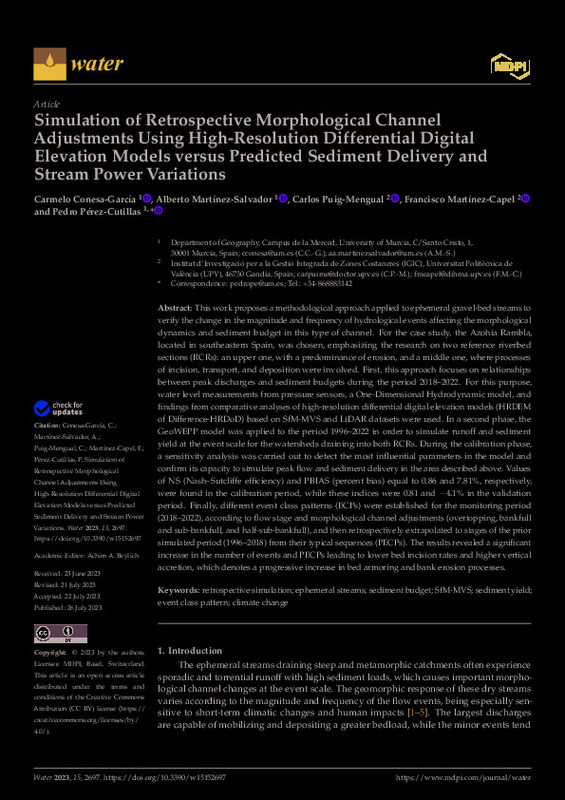JavaScript is disabled for your browser. Some features of this site may not work without it.
Buscar en RiuNet
Listar
Mi cuenta
Estadísticas
Ayuda RiuNet
Admin. UPV
Simulation of retrospective morphological channel adjustments using high-resolution differential digital elevation models versus predicted sediment delivery and stream power variations
Mostrar el registro sencillo del ítem
Ficheros en el ítem
| dc.contributor.author | Conesa-García, Carmelo
|
es_ES |
| dc.contributor.author | Martínez-Salvador, Alberto
|
es_ES |
| dc.contributor.author | Puig-Mengual, Carlos
|
es_ES |
| dc.contributor.author | Martinez-Capel, Francisco
|
es_ES |
| dc.contributor.author | Pérez-Cutillas, Pedro
|
es_ES |
| dc.date.accessioned | 2024-01-10T19:03:43Z | |
| dc.date.available | 2024-01-10T19:03:43Z | |
| dc.date.issued | 2023-08 | es_ES |
| dc.identifier.issn | 2073-4441 | es_ES |
| dc.identifier.uri | http://hdl.handle.net/10251/201746 | |
| dc.description.abstract | [EN] This work proposes a methodological approach applied to ephemeral gravel-bed streams to verify the change in the magnitude and frequency of hydrological events affecting the morphological dynamics and sediment budget in this type of channel. For the case study, the Azohia Rambla, located in southeastern Spain, was chosen, emphasizing the research on two reference riverbed sections (RCRs): an upper one, with a predominance of erosion, and a middle one, where processes of incision, transport, and deposition were involved. First, this approach focuses on relationships between peak discharges and sediment budgets during the period 2018-2022. For this purpose, water level measurements from pressure sensors, a One-Dimensional Hydrodynamic model, and findings from comparative analyses of high-resolution differential digital elevation models (HRDEM of Difference-HRDoD) based on SfM-MVS and LiDAR datasets were used. In a second phase, the GeoWEPP model was applied to the period 1996-2022 in order to simulate runoff and sediment yield at the event scale for the watersheds draining into both RCRs. During the calibration phase, a sensitivity analysis was carried out to detect the most influential parameters in the model and confirm its capacity to simulate peak flow and sediment delivery in the area described above. Values of NS (Nash-Sutcliffe efficiency) and PBIAS (percent bias) equal to 0.86 and 7.81%, respectively, were found in the calibration period, while these indices were 0.81 and -4.1% in the validation period. Finally, different event class patterns (ECPs) were established for the monitoring period (2018-2022), according to flow stage and morphological channel adjustments (overtopping, bankfull and sub-bankfull, and half-sub-bankfull), and then retrospectively extrapolated to stages of the prior simulated period (1996-2018) from their typical sequences (PECPs). The results revealed a significant increase in the number of events and PECPs leading to lower bed incision rates and higher vertical accretion, which denotes a progressive increase in bed armoring and bank erosion processes. | es_ES |
| dc.description.sponsorship | This research was funded by ERDF/Spanish Ministry of Science, Innovation and Universities-State Research Agency (AEI)/Project CGL2017-84625-C2-1-R. State Program for Research, Develop-ment and Innovation focused on the Challenges of Society | es_ES |
| dc.language | Inglés | es_ES |
| dc.publisher | MDPI AG | es_ES |
| dc.relation.ispartof | Water | es_ES |
| dc.rights | Reconocimiento (by) | es_ES |
| dc.subject | Retrospective simulation | es_ES |
| dc.subject | Ephemeral streams | es_ES |
| dc.subject | Sediment budget | es_ES |
| dc.subject | SfM-MVS | es_ES |
| dc.subject | Sediment yield | es_ES |
| dc.subject | Event class pattern | es_ES |
| dc.subject | Climate change | es_ES |
| dc.subject.classification | TECNOLOGIA DEL MEDIO AMBIENTE | es_ES |
| dc.title | Simulation of retrospective morphological channel adjustments using high-resolution differential digital elevation models versus predicted sediment delivery and stream power variations | es_ES |
| dc.type | Artículo | es_ES |
| dc.identifier.doi | 10.3390/w15152697 | es_ES |
| dc.relation.projectID | info:eu-repo/grantAgreement/AEI/Plan Estatal de Investigación Científica y Técnica y de Innovación 2013-2016/CGL2017-84625-C2-1-R/ES/RESPUESTA MORFOLOGICA Y SISTEMICA AL CAMBIO CLIMATICO EN CAUCES EFIMEROS MEDITERRANEOS: DINAMICA, RESILIENCIA Y PROPUESTAS DE ACTUACION/ | es_ES |
| dc.relation.projectID | info:eu-repo/grantAgreement/MINECO//CGL2013-44917-R/ES/CAMBIOS AMBIENTALES Y ANTROPICOS EN CUENCAS FLUVIALES MEDITERRANEAS: IMPACTOS HISTORICOS EN LA MORFOLOGIA, LOS FLUJOS SEDIMENTARIOS Y LA VEGETACION/ | es_ES |
| dc.rights.accessRights | Abierto | es_ES |
| dc.contributor.affiliation | Universitat Politècnica de València. Instituto de Investigación para la Gestión Integral de Zonas Costeras - Institut d'Investigació per a la Gestió Integral de Zones Costaneres | es_ES |
| dc.contributor.affiliation | Universitat Politècnica de València. Escuela Politécnica Superior de Gandia - Escola Politècnica Superior de Gandia | es_ES |
| dc.description.bibliographicCitation | Conesa-García, C.; Martínez-Salvador, A.; Puig-Mengual, C.; Martinez-Capel, F.; Pérez-Cutillas, P. (2023). Simulation of retrospective morphological channel adjustments using high-resolution differential digital elevation models versus predicted sediment delivery and stream power variations. Water. 15(15):1-35. https://doi.org/10.3390/w15152697 | es_ES |
| dc.description.accrualMethod | S | es_ES |
| dc.relation.publisherversion | https://doi.org/10.3390/w15152697 | es_ES |
| dc.description.upvformatpinicio | 1 | es_ES |
| dc.description.upvformatpfin | 35 | es_ES |
| dc.type.version | info:eu-repo/semantics/publishedVersion | es_ES |
| dc.description.volume | 15 | es_ES |
| dc.description.issue | 15 | es_ES |
| dc.relation.pasarela | S\498354 | es_ES |
| dc.contributor.funder | MINECO | es_ES |
| dc.contributor.funder | European Regional Development Fund | es_ES |
| dc.contributor.funder | Ministerio de Economia, Industria y Competitividad | es_ES |
| dc.subject.ods | 11.- Conseguir que las ciudades y los asentamientos humanos sean inclusivos, seguros, resilientes y sostenibles | es_ES |
| dc.subject.ods | 13.- Tomar medidas urgentes para combatir el cambio climático y sus efectos | es_ES |
| dc.subject.ods | 15.- Proteger, restaurar y promover la utilización sostenible de los ecosistemas terrestres, gestionar de manera sostenible los bosques, combatir la desertificación y detener y revertir la degradación de la tierra, y frenar la pérdida de diversidad biológica | es_ES |








